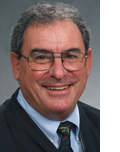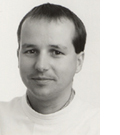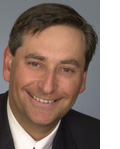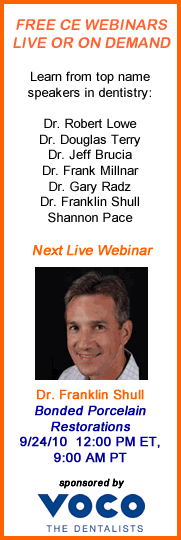A member service that keeps you up-to-date on important new literature relevant to your practice.
 |
|
Our contributors highlight articles on pulp capping, traumatic dental injuries, adhesive bond-strength tests and treatments for temporomandibular disorder in this issue of JCDA Express.
JCDA would once again like to thank the publishers of the selected articles, who have granted free access to the full-text papers until October 16, 2010. Follow the links in the Notes and News sidebar to learn more about these publications.
JCDA Express can also be accessed via our website at JCDA.ca. We are excited to offer new audiovisual features that enhance our traditional offering of clinical research articles. Drs. Richard Price and Mary Dabuleanu have created a YouTube video and a narrated presentation respectively, to help dental practitioners at the point of care. If you are interested in making a similar audiovisual contribution to JCDA.ca, please contact me by email.
Yours sincerely,
Dr. John P. O'Keefe
Editor-in-chief
jokeefe@cda-adc.ca
|
|
 |
|
|
Pulp Capping

Dr. Terry Donovan is chair of biomaterials in the department of operative dentistry, University of North Carolina at Chapel Hill School of Dentistry. Dr. Donovan, a JCDA editorial consultant, recommends:
Hilton TJ. Keys to clinical success with pulp capping: a review of the literature. Oper Dent. 2009;34(5):615-25.
View full text of this article
Full-text access to this article has expired.
Key points:
-
A well-sealed restoration is the key to pulp survival after an indirect or direct pulp cap. If the tooth is asymptomatic and a well-sealed restoration has been placed, the chances of long-term survival of the tooth are very good.
-
Dentists should avoid exposing the pulp at all costs. The evidence shows that it is preferable to leave residual caries in the tooth rather than exposing the pulp.
-
If the pulp is exposed, hemorrhage must be controlled before capping. Water, saline or sodium hypochlorite can effectively control bleeding.
-
Calcium hydroxide remains the gold standard material for direct pulp capping. It has the longest track record and is the most cost-effective material.
-
Mineral trioxide aggregate (MTA) has shown comparable results to calcium hydroxide as a direct pulp capping agent in the short term. However, it has not demonstrated superior results over calcium hydroxide, despite exuberant claims by some experts.
-
MTA is effective as a pulp capping agent because it produces calcium hydroxide while setting; once the MTA has set, it acts as a reservoir for calcium hydroxide.
-
Zinc oxide eugenol, glass ionomer, resin-modified glass ionomer and dentin adhesives are very poor materials for use in direct pulp capping and should not be used for this purpose.
Reasons for recommending this article:
There are times when clinical dentists should consider performing an indirect or direct pulp cap because, when successful, this procedure may allow some patients to retain a tooth without incurring the expense of endodontic therapy and crown placement. However, there is confusion in the profession regarding the effectiveness of pulp capping and the optimal materials and techniques for such procedures. This is further complicated by the aggressive marketing of some materials and exaggerated claims of efficacy. Dr. Hilton reviews the extensive literature on pulp capping, provides an evidence-based analysis of the issues, and comes to very specific conclusions that should be valuable to all restorative dentists.
|
|
 |
|
|
|
Traumatic Dental Injuries

Dr. Azita Zerehgar is a pediatric dentist from Toronto. Dr. Zerehgar recommends:
Andreasen JO, Laurdisen E, Andreasen FM. Contradictions in the treatment of traumatic dental injuries and ways to proceed in dental trauma research. Dent Traumatol. 2010;26(1):16-22. Epub 2009 Oct 7.
View full text of this article
Full-text access to this article has expired.
Key points:
- This article reviews the evidence underpinning many standard treatment protocols for traumatic dental injuries such as crown fractures, root fractures, luxations and avulsions. Because of contrary evidence from some recent clinical studies, the authors question the strength of the scientific basis for many of dentistry’s standard treatments for such injuries.
- In crown fractures, while the standard concept is dentin coverage to prevent bacterial ingress, the authors assert that positive pulp pressure leads to dentinal fluid flow that may mechanically inhibit the invasion of bacteria through the tubules.
- For root fractures, the authors claim that neither a delay in treatment up to several days nor prolonged splinting has any influence on the healing process. In addition, no splinting at all or flexible splinting has been shown to be more favourable than rigid splinting.
- For luxation, the authors argue that optimal repositioning of the tooth has no significant positive effects on pulp healing. Also, antibiotics may have a negative effect on periodontal healing in cases of luxation and root fractures. Further, the repositioning procedure may actually cause damage to the periodontal ligament and pulp and increase the risk of pulp necrosis, root resorption and marginal healing complications.
- In avulsions, prompt replantation, proper rinsing of the tooth and antibiotic therapy have been the standard treatment concepts. The authors highlight contradictory findings in studies on the effect of rinsing root surfaces, with root resorption occurring after rinsing. In addition, in a severely damaged pulp and/or periodontal ligament, systemic antibiotics may not diffuse effectively into the target area.
Reasons for recommending this article:
Dr. J.O. Andreasen is a global leader in the field of dental trauma. This thought-provoking article highlights recent clinical studies that provide evidence about treatments that is contrary to what some might expect. The authors use these results to call into question the strength of the evidence for many of our accepted treatments of dental trauma. I believe it is good to question what we do routinely, as today’s scientific heresy may become tomorrow’s received wisdom.
Knowledge of the imperfections of standard treatment protocols may help explain unintended consequences of our treatments. Much research still needs to be done in dental trauma, but researchers face many obstacles in trying to conduct conclusive clinical trials in this discipline. In light of these limitations, a website (www.dentaltraumaguide.org) devoted to the diagnosis and treatment of a range of traumatic dental injuries created by Dr. Andreasen and his colleagues at the University of Copenhagen is a very interesting and comprehensive resource.
|
|
 |
|
|
Bond-Strength Tests for Adhesives

Dr. Richard Price is a professor in the department of dental clinical sciences at Dalhousie University. Dr. Price, a JCDA editorial consultant, recommends:
Van Meerbeek B, Peumans M, Poitevin A, Mine A, Van Ende A, Neves A, et al. Relationship between bond-strength tests and clinical outcomes. Dent Mater. 2010;26(2):e100-21. Epub 2009 Dec 16.
View full text of this article
Full-text access to this article has expired.
Key points:
- The authors reviewed 744 articles that evaluated the bond strength between tooth structures and dental resins. There was great variation in the in vitro testing methods used and the bond strength results reported for the same materials.
- The most popular bond-strength test was the microtensile test (60% of the reviewed articles used this approach), followed by the macroshear, microshear and macrotensile tests. The microtensile bond-strength test appears to be more effective than traditional shear bond-strength tests in discriminating between adhesives based on their bonding performance.
- Most bond-strength studies tested bond strength immediately or after 24 hours. This is not ideal. A well-validated method to assess bond durability involves storing microspecimens in water for at least 3 months. After that time, all classes of adhesives have shown mechanical and morphological evidence of degradation that resembles more what occurs in in vivo results.
- The authors found a significant correlation between the “aged” or longer term bond-strength data and the 5-year clinical data. No one-to-one relationship was established between the in vitro and in vivo 2-year data. This may be because many adhesives show a very high retention rate after that time period (about half of the studies had retention rates higher than 95% at 2 years).
- Ideally, clinical effectiveness of adhesives should be assessed with clinical trials that use non-retentive Class V preparations. Class V resin restorations should last for a long period of time. In one reviewed study, 94% of the restorations in the control group (OptiBond FL in combination with Prodigy, Kerr) were still functioning after 13 years of clinical service.
- When selecting an adhesive for use in their practice, clinicians should look for the results of clinical trials and in vitro studies that report “aged” bond strength results. These studies should include a traditional 3-step etch and rinse adhesive in the control group.
Reasons for recommending this article:
Practitioners want a secure long-term bond between the resins they place and tooth structure. However, it is difficult to choose among the many adhesive products available on the market. To further complicate matters, manufacturers often promote and release successor or “next generation” adhesive products before the precursor has been clinically evaluated for at least 5 years. This article, presented at the 2009 Academy of Dental Materials meeting, is a current and comprehensive review of the evidence on the clinical effectiveness of bond-strength tests. The authors found that all-in-one, self-etch adhesives have the shortest and least proven clinical track record. They conclude that traditional, 3-step etch and rinse adhesives remain the gold standard among these products. Two-step self-etch adhesives, preferably combined with selective enamel etching with phosphoric acid, appear equally effective.
Interview with Dr. Bart Van Meerbeek:

Dr. Bart Van Meerbeek, lead author of the article on bond-strength tests, discusses what he considers an acceptable "aged" bond strength; which bonding technique and system can achieve the most clinically reliable bond; and how the use of flowable resins under stiffer composites affects bond strength. Dr.Van Meerbeek also cites 2 brand names of bonding systems he considers to be of gold-standard quality.
|
|
 |
|
|
Treatment for Temporomandibular Disorders

Dr. Howard Tenenbaum is a professor of periodontology at the University of Toronto, University of Manitoba and Tel Aviv University, Israel. Dr. Tenenbaum recommends:
Treatment for temporomandibular joint dysfunction: guidelines. Canadian Agency for Drugs and Technologies in Health. Health Technology Inquiry Service Report. Ottawa, Ontario. 17 May 2010.
View full text of this report
Full-text access to this article has expired.
Key points:
- This report reviews the many potential treatments for patients with temporomandibular disorders (TMDs).
- Most of these treatments (e.g., acupuncture, bite planes, behavioural therapy, physical therapy, pharmacologic treatments, electrophysical treatments, surgical treatments) have similar degrees of efficacy for the management of TMD.
- This review reported significant concerns that the current quality of evidence to support any particular treatment modality is questionable and may be of moderate to low value.
- One surprising conclusion was that surgical joint replacement had very little evidence of efficacy. However, I believe the authors of the report are discussing joint replacement in general for a wide range of TMD conditions, which could account for the low efficacy. If the report had focused on more disease-specific issues (e.g., treatment of pathologic or traumatic destruction of the temporomandibular joint), it may have supported the use of surgical joint replacement under more specific conditions. An apparent lack of evidence in the current literature prevented this.
- Because most TMD treatments (except occlusal adjustment) seem to yield significant benefit, a prudent practitioner should consider the use of the least invasive and most reversible treatment options. This might also lead to the utilization of the least expensive treatment approaches.
Reasons for recommending this report:
This report is very useful for general practitioners because it shows how much evidence is required before any particular treatment for TMD can be endorsed—and that despite a wealth of research, such proof is not available yet. However, the review does show that many diverse TMD treatments are effective. With this in mind, a clinician can advise patients to avoid treatments that are overly invasive, highly expensive and of debatably better outcomes than noninvasive and reversible treatments. The latter treatments are also often much less expensive. I believe that when patients present with problems that do not respond to simple, noninvasive and reversible measures for relief of pain, dentists should consider referring these patients to a specialist.
|
|
|
|
|

JCDA is the authoritative written voice of the Canadian Dental Association, providing dialogue between the national association and the dental community. It is dedicated to publishing worthy scientific and clinical articles and informing dentists of issues significant to the profession.

|


|
NOTES AND NEWS
Audiovisual presentations on JCDA.ca
Price RBT, Felix CM, Whalen M. Factors affecting the energy delivered to simulated Class I and Class V preparations.
J Can Dent Assoc 2010;76:a94.
Dabuleanu M. Managing calcified canal systems: Audiovisual presentation.
J Can Dent Assoc 2010;76:a128.
Check out the publications featured in this issue
Operative Dentistry
Dental Traumatology
(publisher: Wiley)
Dental Materials
(publisher: Elsevier)
Share your volunteer experiences on the new DISCUSSIONS section of the JCDA website
www.jcda.ca/discussions/
2011 CDA convention: New details on website
The next CDA convention will take place in Halifax, August 4-6, 2011. New registration and program details have been added to cdaconvention2011.com
Search the JCDA Classified Ads
Looking for employment? Want to sell your practice? Classified ads offer the most effective way to reach all dentists and students in Canada.
Spread the word
Help spread the word about JCDA Express by telling your colleagues about it and reminding them to send CDA their email address.
reception@cda-adc.ca
|
|
|

|

|
|



